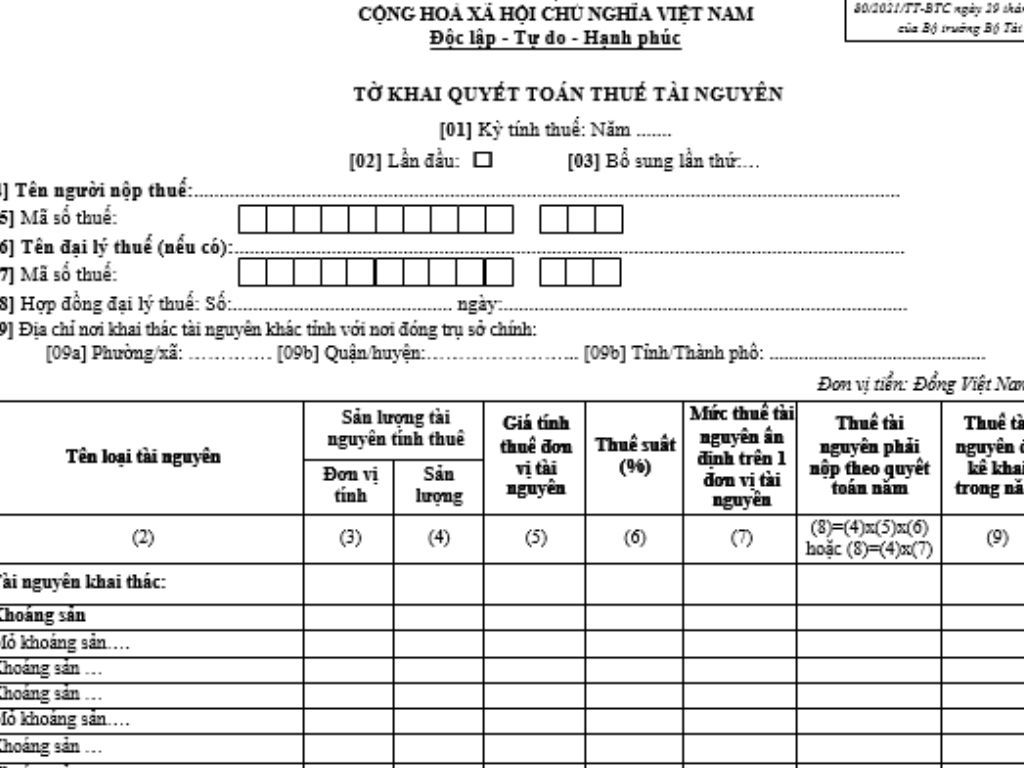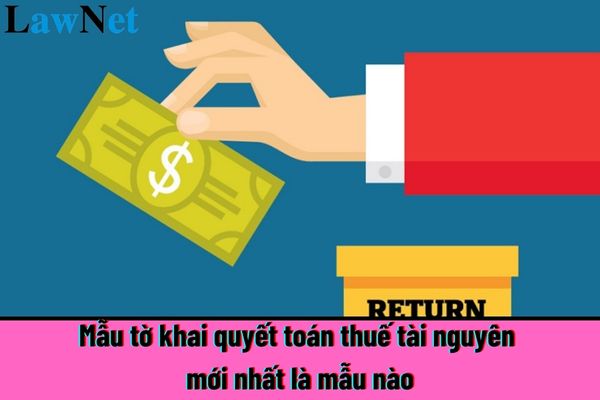What is the latest resource royalty finalization form in Vietnam?
What is the latest form of the resource royalty finalization in Vietnam?
Currently, the form for the resource royalty finalization is form number 02/TAIN in Appendix 2 issued together with Circular 80/2021/TT-BTC. To be specific:

>> Latest resource royalty finalization form Download

What is the latest resource royalty finalization form in Vietnam? (Image from the Internet)
What are the bases for calculating resource royalty in Vietnam?
Pursuant to Article 4 of Circular 152/2015/TT-BTC, the bases for calculating resource royalty are stipulated as follows:
- The bases for calculating resource royalty include taxable natural resource output, the price for calculating resource royalty, and the resource royalty rate.
- The formula for determining the resource royalty payable during the period:
resource royalty payable during the period = Taxable natural resource output x Unit price for calculating resource royalty x resource royalty rate
- In cases where the state authority determines the fixed resource royalty payable per unit of exploited natural resource, the resource royalty payable is determined as follows:
resource royalty payable during the period = Taxable natural resource output x Fixed resource royalty rate per unit of exploited natural resource
The determination of resource royalty is based on the Tax authority's database, in accordance with the regulations on tax determination under the legal provisions for tax management.
Who is subject to resource royalty?
According to Article 2 of Circular 152/2015/TT-BTC, those subject to resource royalty include natural resources within the territorial land, islands, inland waters, territorial sea, contiguous zone, exclusive economic zone, and continental shelf falling under the sovereignty and jurisdiction of the Socialist Republic of Vietnam as prescribed, including:
- Metallic minerals.
- Non-metallic minerals.
- Products of the natural forest, including various types of vegetation and other products of the natural forest, excluding animals, and star anise, cinnamon, cardamom, and amomum grown by taxpayers in the areas of natural forest assigned for protection and fostering.
- Natural aquatic products, including marine animals and vegetation.
- Natural water, including: Surface water and groundwater; excluding natural water used for agriculture, forestry, fishery, salt production, and seawater for cooling machinery.
Seawater used for cooling machinery must meet environmental requirements, efficient use of circulating water, and technical-economic conditions per the approval of competent state authorities. If the use of seawater causes pollution not meeting environmental standards, it must be dealt with according to regulations.
- Natural bird's nests, excluding those obtained from investment activities by organizations or individuals in constructing nest houses to attract wild birds for farming and exploitation.
Bird's nests obtained from investment activities in constructing nest houses for the attraction of wild birds must comply with regulations.
- Other natural resources as specified by the Ministry of Finance in cooperation with relevant Ministries and sectors, reporting to the Government of Vietnam for submission to the Standing Committee of the National Assembly for consideration and decision.
Which entities are resource royalty payers in Vietnam under current regulations?
Persons liable for resource royalty as prescribed in Article 3 of Circular 152//2015/TT-BTC include organizations and individuals exploiting resources subject to resource royalty as stated in Article 2 of Circular 152/2015/TT-BTC, collectively referred to hereinafter as taxpayers, in certain cases specifically stipulated as follows:
- For mineral resource exploitation activities, the taxpayer is the organization or household business granted a Mineral Exploitation Permit by a competent state authority.
+ In cases where an organization granted a Mineral Exploitation Permit by a competent state authority is authorized to cooperate with another organization or individual in exploiting resources and has specific provisions for tax liability, the resource royaltypayer is determined based on that document.
+ In cases where an organization granted a Mineral Exploitation Permit subsequently assigns the exploitation rights to its subsidiaries, each exploiting unit is a resource royaltypayer.
- Enterprises established on the basis of joint ventures for resource exploitation purposes will have the joint venture company as the taxpayer.
+ If both Vietnam and foreign parties participate in the execution of a business cooperation contract for resource exploitation, the tax liability of the parties must be specified in the cooperation contract; If not explicitly stated, all parties to the contract are required to cumulatively declare and pay resource royalty, or appoint a representative for tax payment under the contract.
- Organizations or individuals undertaking construction work contracts that result in natural resource outputs permitted or not contravening legal provisions for resource management and exploitation, when utilized or consumed, must declare and pay resource royalty to the local tax authority where the resources are extracted.
- Organizations or individuals using water from irrigation projects for electricity generation shall be recognized as resource royaltypayers under this Circular, regardless of the funding source for the irrigation project.
In cases where an irrigation management organization supplies water to other organizations or individuals for domestic water production or other purposes (excluding electricity generation), the irrigation management organization shall be recognized as the resource royaltypayer.
- For natural resources prohibited from or illegally exploited found and seized but permitted to be sold, the organization assigned to sell must declare and pay resource royalty for each occurrence at the tax authority managing the entity before deducting any costs related to the seizure activities, auction sale, and awarding according to the policy stipulations.

